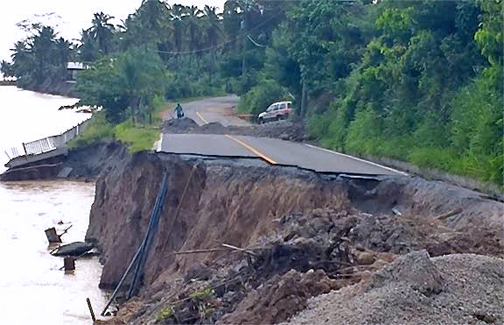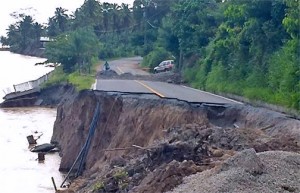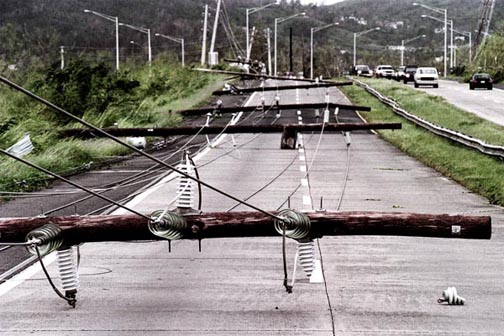Dominica seeks U.S. help to rebuild after Erika damage


In all, 31 people died, with damage to Dominica alone estimated by the World Bank at $444 million. (Credit: Embassy of Dominica)
With only 73,000 inhabitants, the Caribbean island of Dominica lacks beaches but is blessed with pristine waterfalls, virgin rainforests and an unusual boiling lake situated in Morne Trois Pitons National Park, only six miles due east of the capital, Roseau.
Yet nature has not always been kind to Dominica.
On Sept. 20, 1834, a powerful hurricane slammed into the island, causing a 12-foot storm surge that devastated Roseau and left 230 people dead. On Aug. 29, 1979, Hurricane David — a Category 5 storm with 150 mph winds — destroyed or damaged 80 percent of Dominica’s homes, obliterated the banana crop and killed 56 people.
This year, disaster struck again in the form of Tropical Storm Erika, which arrived Aug. 28, dumping 10 inches of rain on the island, causing catastrophic mudslides and flattening entire villages before moving on to Guadeloupe, Puerto Rico and the Dominican Republic.
In all, 31 people died, with damage to Dominica alone estimated by the World Bank at $444 million. Prime Minister Roosevelt Skerrit said Erika has set the country back by 20 years in terms of development — a sentiment shared by Dominica’s longtime ambassador to the United States, Hubert John Charles.
“The point is, we need to reconstruct,” he said in a recent interview. “Two villages, Petit Savanne and Dubique, have been declared uninhabitable. Vulnerability has increased and the ground is now unstable. We’re practically starting over.”
One mountaintop weather station located at Gleau Gommier, in the center of the island, recorded 17.08 inches of rain within an 18-hour period from 1 a.m. to 5 p.m.
Charles said most of the deaths occurred in Petit Savanne, home of Dominica’s bay oil industry. In addition, Douglas-Charles Airport, on the island’s northeast coast, suffered $15 million in damages and had to be closed for two weeks. Since it’s reopening, the airport can only accommodate daytime landings since all the night-landing equipment on the tarmac was destroyed.
Meanwhile, the entire population of Dubique will be resettled elsewhere, in 50 houses donated by the Venezuelan government. Likewise, St. Kitts pledged EC$1 million ($370,000), while Cuba sent doctors to deal with Erika-related medical emergencies.
And even though Dominica broke relations with Taiwan upon granting diplomatic recognition to mainland China 10 years ago, both rivals gave the island cash in its time of need (Beijing sent $300,000 and Taipei $100,000).
“We are happy with the response we got from the international community. Several prime ministers came down and offered assistance,” he said. “Japan offered generators and water tanks, Chile provided resources, and so did Colombia, Mexico and even the British Virgin Islands. The generosity of the Caribbean governments is something we will never forget.”
U.S. ‘could do more’
Yet the United States “could do a little bit more,” Charles said diplomatically.
On Capitol Hill, the loudest proponents of help for Dominica are Rep. Stacey Plaskett, the nonvoting delegate from the U.S. Virgin Islands, and two New York Democrats — Rep. Yvette Clarke and Rep. Eliot Engel — both of whom have large numbers of English-speaking Caribbean immigrants in their respective districts.
Plaskett visited Dominica after the storm, and on Sept. 30 she sponsored a House resolution “expressing the sense … that the U.S. government should provide additional relief and assistance to the island of Dominica” — in addition to the $150,000 the Obama administration has already provided.
“The risk is, people will forget there was a tragedy in Dominica,” Charles warned. “Right after that, Hurricane Joaquin hit the Bahamas, and of course people can say to us, ‘you don’t have the problems that Syria has. Look at those refugees.’ But those arguments don’t help us.”
Charles declined to specify how much aid he wants from Washington.
“I would be hesitant to give a figure,” said the ambassador. “But given the frequency of these natural disasters in the Caribbean, and given our proximity and the long-term engagement of the U.S. in our development, I think it is appropriate for the United States to consider the idea of establishing a disaster relief fund for the Caribbean.”
Dominica’s challenge is especially great. Its debt-to-GDP ratio is a staggering 81.1 percent, meaning it can’t afford to keep rebuilding every time a hurricane hits the island. In addition, Dominica has no beaches, so it can’t count on the income from mass tourism as other Caribbean destinations do.
Furthermore, people often confuse Dominica with the similar-sounding but more familiar Dominican Republic — and finally, the United States has no embassy there.
Engel hopes to change that, however. In March, the congressman introduced his U.S.-Caribbean Partnership Act, which seeks to establish new embassies in Dominica and four other English-speaking island nations: Antigua & Barbuda, St. Kitts & Nevis, St. Lucia and St. Vincent & the Grenadines.
At present, the U.S. Embassy in Bridgetown, Barbados, handles all diplomatic and consular affairs with the five countries. But Erika may have inadvertently given Engel’s bill a boost, said Charles.
“All five of us ambassadors have met and agreed we would together show our solidarity and support for the initiative,” he said, adding that “the presence of an U.S. Embassy in Dominica would give the United States a better understanding of the development challenges we face.”









